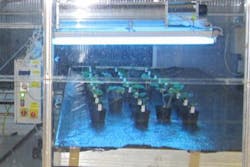| Cucumbers infected with powdery mildew are treated with UV-B and blue light as part of an experiment to see what spectral combinations can suppress the pathogen. (Image: Aruppillai Suthaparan) |
Researchers at Cornell University (Ithaca, NY) and the Norwegian University of Life Sciences, Plant & Environmental Sciences (Ås, Norway) are using daily UV-B light exposures at an intensity of only 1 W/m2 for 10 to 15 minutes to suppress powdery mildew in cucumbers.1 However, blue or UV-A light along with the UV-B light reduced the effectiveness of the technique. Red light on its own or with UV-B also helped a bit against powdery mildew.
The UV-B light treatment, which is especially effective when applied at night, can reduce the severity of powdery mildew from about 90% to about 5% of leaf area.
While the study focused on Podosphaera xanthii, one fungal species that infects cucumber, researcher Aruppillai Suthaparan of the Norwegian University of Life Sciences has used the treatment to suppress species of powdery mildew fungi that infect other crops, including grape, strawberry, rose, and basil. Cornell researcher David Gadoury says he hopes to develop a more sophisticated understanding by finding the fungal genes involved in light responses and pinpointing the exact wavelengths of light involved.
“Powdery mildews go after just about everything we want to grow,” Gadoury says. “I feel fairly safe in saying we could kill any powdery mildew with UV-B. Right now we’re at the caveman level. We’ve discovered this club, and we’re going to whack powdery mildew until we kill it.”
Source: http://www.news.cornell.edu/stories/2014/05/uv-b-light-zaps-cucumber-disease
REFERENCE:
1. Aruppillai Suthaparan et al., Plant Disease (2014); http://dx.doi.org/10.1094/PDIS-03-13-0222-RE
